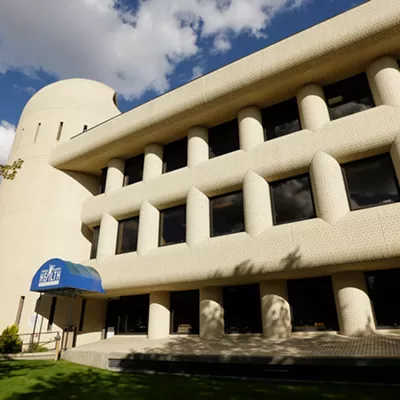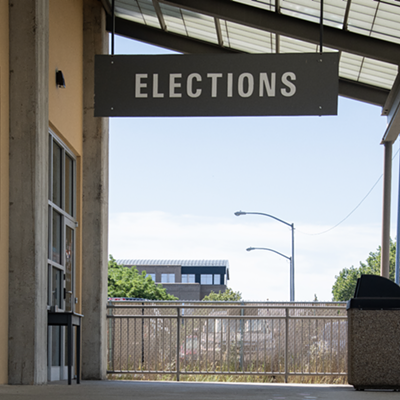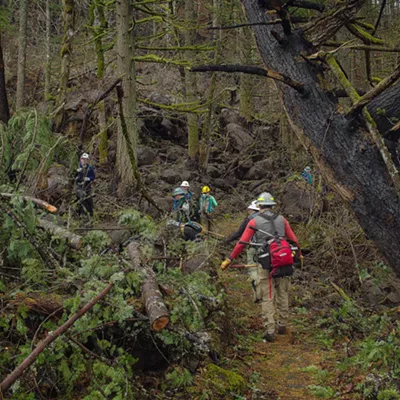Many in the neighborhood are calling it a shack. It's that drive-through video store, recently opened in the parking lot of the Taco Time located just south of St. John's Cathedral, between 12th and 13th on Grand Boulevard.
This description, however, may be overly charitable. When we tack on the garish signage, the feeble attempts to comply with our loose landscaping requirements, the porta-sign encroaching on the roadway -- when we add all this, and then paint into the background St. Johns Cathedral, it's theater of the absurd. But it's also a symbol of what has for years contributed to Spokane's low morale, cynicism and sense of futility.
I have no quarrel with the owners of this new business -- after all, they only did what the city told them they could do. Rather, I offer the tale of the shack as a case study in institutional obliviousness and arrogant disregard so typical of decision-making here.
The decision-making trail that ends at the shack winds from the Planning Department to the City Council. Our elected and appointed guys and gals made promises, both during the creation of the recently approved Comprehensive Plan, and before that in the Neighborhood Specific Plan. Now, as the presence of the shack dramatizes, it's obvious that those promises are not being kept.
Might we say without fear of contradiction that no one who worked on either the Comprehensive Plan or the earlier Neighborhood Specific Plan would be in favor of this shack? Indeed, those who were party to the decision left the proceedings believing that action had been taken which would prevent such development.
And while the council, during the Comprehensive Plan hearings, gave ground to the arguments and protestations that came from the business community regarding regulations, in the end the council did pass a plan that, even while watered down, should have afforded protection against such ugly ventures as the shack. The council could have exercised more political will, as is always the case, and addressed the threat directly. Espresso stands and such businesses could have simply been subjected to the special permitting process. After all, the problems posed by this new business phenomenon called espresso stands is now understood. Most of them are shacks, which allows them to fly in low, under the protection afforded against drive-throughs, which are subject to a variety of regulations.
A number of years ago, this very Taco Time sought approval for a drive-through. They needed a special permit and failed to obtain it -- as the video shack would have failed if the council had done nothing other than extend existing drive-through protections to espresso stands. But because the council couldn't figure out what to do about espresso stands, they punted; thus the video shack guys were not required to obtain a special permit.
Even so, the Comprehensive Plan speaks to the general challenges posed by signage, design, scale and the like. The approved "Centers and Corridors" plan establishes the vicinity around the Grand Boulevard Taco Time as a "Neighborhood Center." As such, commercial facilities catering to drive-through traffic will be permitted only on principal arterials and will be subject to "size limitations and design review." Neighborhood centers are to be pedestrian friendly, and the plan addressed the importance of an urban tree-scape. On-premise signage must contribute to "a positive visual character of the community." The shack construction fails all these tests.
But the Comprehensive Plan has yet to be codified, and city staff members points out that until the Comprehensive Plan is codified, prior regulations are in effect. And here we come to the rub.
This dismal tale really begins a decade ago, when, in
the early '90s, all Community Development Block
Grant neighborhoods were required to develop a specific plan. Dutifully, if naively, citizens responded once again to the call from the city to serve and began deliberations. In 1993, following two years of discussions and debates, the draft plan was completed. Negotiations were often difficult. The neighborhood wanted down-zoning. Some property owners opposed such a move. Then Councilman Joel Crosby, on his own, stepped in, called all the parties to the table and slowly mediated a solution. Finally, in 1994 the plan was adopted by the council.
Far from your typical NIMBY plan, the Manito-Cannon Hill plan, which includes the property now playing home to the shack, called for more urbanization, not suburbanization. It called for higher density and mixed use. It called for more commercial development. It called for the city to relax on-premise parking requirements. In an early draft, it even called for zoning that would permit a neighborhood pub to open up (Councilwoman Bev Numbers was particularly offended by this decidedly urban idea, and it was later dropped). In exchange, the plan did address the problem of use, size and scale. Ironically, it was a plan that actually would have encouraged Taco Time to develop part of its parking lot in other ways.
So if the Specific Plan was approved way back in 1994, why didn't it provide the neighborhood the needed protection until such time as the Planning Department staff could codify the newly approved Comprehensive Plan?
Turns out that city staff, on its own -- with apparent disregard for all the citizens who invested so much time into the Specific Plan and also for the City Council that had approved the plan --decided not to codify that earlier plan. As one planner told me, it was because the Comprehensive Plan was on the way and once completed, the new document would supersede the Specific Plan. That was back in 1994.
Nearly eight years ago!
Since 1994, all the citizens who thought they were protected by the Specific Plan were living in a fool's paradise. The staff did not even have the courtesy to inform the public what it had decided to do. Nor, my guess is, was the council ever informed. On the other hand, one might ask why it was that the council failed to oversee the execution of its own policy?
What we know is that the erection of the shack would not have been permitted had the staff done nothing more than codify the council-approved Specific Plan.
Citizens in Spokane have long complained about being used. You are asked to sit on a committee, you do what's asked, you often even see what you produce approved by both appointed and elected authorities. Then you wait... and wait... and wait... and nothing changes. Business as usual. But arrogant disregard does not go unnoticed. When citizens are used, they know it. Cynicism follows. This shack offers us a representative example of such disregard, and the resultant community cynicism should come as no surprise. But the shack is also a vision of what kind of development the entire city, not just Grand Boulevard, may be in for. We all agreed on what we want our city to look like in the form of not one but two planning documents, but despite all that it looks like any parking lot in the city is shack-worthy.
But don't worry. The City, no doubt, plans to form an "Interim Shack Regulation Committee." They'll want you to join.
Robert Herold lives in the Manito-Cannon Hill neighborhood and worked on its Neighborhood Specific Plan.
















